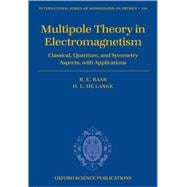
Note: Supplemental materials are not guaranteed with Rental or Used book purchases.
Purchase Benefits
Looking to rent a book? Rent Multipole Theory in Electromagnetism Classical, Quantum, and Symmetry Aspects, with Applications [ISBN: 9780198567271] for the semester, quarter, and short term or search our site for other textbooks by Raab, R. E.; de Lange, O. L.. Renting a textbook can save you up to 90% from the cost of buying.
| 1 Classical multipole theory | 1 | (31) | |||
|
1 | (4) | |||
|
5 | (1) | |||
|
6 | (1) | |||
|
7 | (1) | |||
|
8 | (2) | |||
|
10 | (2) | |||
|
12 | (1) | |||
|
13 | (1) | |||
|
14 | (1) | |||
|
15 | (2) | |||
|
17 | (1) | |||
|
18 | (5) | |||
|
23 | (2) | |||
|
25 | (2) | |||
|
27 | (2) | |||
|
27 | (1) | |||
|
28 | (1) | |||
|
29 | (3) | |||
| 2 Quantum theory of multipole moments and polarizabilities | 32 | (27) | |||
|
32 | (1) | |||
|
33 | (4) | |||
|
37 | (1) | |||
|
38 | (2) | |||
|
40 | (5) | |||
|
45 | (2) | |||
|
47 | (3) | |||
|
50 | (1) | |||
|
51 | (1) | |||
|
52 | (1) | |||
|
53 | (1) | |||
|
54 | (2) | |||
|
56 | (3) | |||
| 3 Space and time properties | 59 | (25) | |||
|
59 | (1) | |||
|
60 | (2) | |||
|
62 | (3) | |||
|
65 | (2) | |||
|
67 | (3) | |||
|
70 | (5) | |||
|
75 | (4) | |||
|
79 | (3) | |||
|
82 | (1) | |||
|
82 | (2) | |||
| 4 Linear constitutive relations from multipole theory | 84 | (16) | |||
|
84 | (2) | |||
|
86 | (1) | |||
|
86 | (4) | |||
|
90 | (2) | |||
|
92 | (3) | |||
|
92 | (1) | |||
|
93 | (1) | |||
|
94 | (1) | |||
|
95 | (3) | |||
|
98 | (2) | |||
| 5 Transmission and scattering effects: direct multipole results | 100 | (45) | |||
|
100 | (3) | |||
|
103 | (3) | |||
|
106 | (4) | |||
|
110 | (1) | |||
|
111 | (1) | |||
|
112 | (3) | |||
|
115 | (3) | |||
|
118 | (2) | |||
|
120 | (4) | |||
|
124 | (3) | |||
|
127 | (9) | |||
|
128 | (1) | |||
|
129 | (1) | |||
|
130 | (1) | |||
|
131 | (1) | |||
|
132 | (1) | |||
|
133 | (2) | |||
|
135 | (1) | |||
|
136 | (4) | |||
|
140 | (1) | |||
|
141 | (4) | |||
| 6 Reflection effects: direct multipole results | 145 | (27) | |||
|
145 | (2) | |||
|
147 | (3) | |||
|
150 | (3) | |||
|
153 | (3) | |||
|
156 | (6) | |||
|
162 | (3) | |||
|
165 | (3) | |||
|
168 | (1) | |||
|
169 | (1) | |||
|
170 | (2) | |||
| 7 Transformations of the response fields and the constitutive tensor | 172 | (6) | |||
|
172 | (1) | |||
|
173 | (1) | |||
|
174 | (1) | |||
|
174 | (3) | |||
|
177 | (1) | |||
| 8 Applications of the gauge and Faraday transformations | 178 | (13) | |||
|
178 | (2) | |||
|
180 | (3) | |||
|
183 | (3) | |||
|
186 | (3) | |||
|
189 | (2) | |||
| 9 Transmission and reflection effects: transformed multipole results | 191 | (20) | |||
|
191 | (1) | |||
|
192 | (3) | |||
|
195 | (2) | |||
|
197 | (1) | |||
|
198 | (1) | |||
|
199 | (3) | |||
|
202 | (3) | |||
|
205 | (1) | |||
|
206 | (1) | |||
|
206 | (4) | |||
|
210 | (1) | |||
| A Transformations involving J | 211 | (2) | |||
| B Magnetostatic field | 213 | (1) | |||
| C Magnetostatic force | 214 | (1) | |||
| D Magnetostatic torque | 215 | (1) | |||
| E Integral transformations | 216 | (2) | |||
| F Origin dependence of a polarizability tensor | 218 | (2) | |||
| G Invariance of transformed tensors | 220 | (1) | |||
| Glossary of symbols | 221 | (8) | |||
| Index | 229 |
The New copy of this book will include any supplemental materials advertised. Please check the title of the book to determine if it should include any access cards, study guides, lab manuals, CDs, etc.
The Used, Rental and eBook copies of this book are not guaranteed to include any supplemental materials. Typically, only the book itself is included. This is true even if the title states it includes any access cards, study guides, lab manuals, CDs, etc.